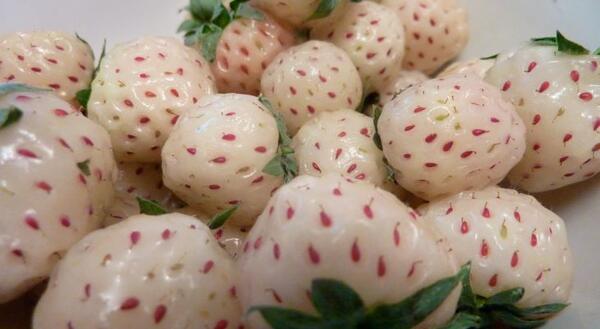
Strawberries (Fragaria species) are one of summer’s best treats.
Strawberry varieties
Depending on the cultivar, strawberries differ in when they produce berries and what their berries look like.
- June-bearing strawberries provide a large crop of larger berries.
- Everbearing strawberries produce smaller berries throughout the growing season.
- Novelty types of strawberries can range in color (purple, yellow, white) and flavor.
One unique novelty strawberry is the pineberry.
What is a pineberry?
Introduced commercially to the United States in 2012, pineberries are hybrid, everbearing, white strawberries with red seeds, and they have the flavor and aroma of pineapple. Pineberries can turn pink when growing in sunlight, and slow down or stop producing during the intense heat of summer. Growers have reported that pineberries are a soft berry. Compared to strawberries, pineberries are smaller, about an inch in diameter, depending on the cultivar.
There are six cultivars available in the U.S.
- White Pine
- White D
- White Albino
- White Carolina
- Wonderful
- Natural Albino®.
What to know when growing pineberries
When planting pineberries, start with a weed-free, well-drained site in full sun. Plant them one foot apart within the row and mulch with 4-6 inches of weed-free straw. Straw will have multiple benefits for your pineberries: it will suppress weed growth, retain moisture, and hold heat to protect berries during the winter.
Pineberries are not self-fertile, meaning they require a second cultivar to cross-pollinate. One pollinator strawberry is necessary for every four pineberries. Purchase pineberries in the spring as transplants because they are hybrids and the seeds will not grow true to type.
Pineberries are hardy in zones 5-8 and have management similar to other everbearing strawberries. It is recommended that everbearing plants are planted in a hill system. In the hill system, cut off runners as they appear. Cutting off runners allows all of the energy to remain in the mother plant. If allowed to produce runners, flowering and fruiting will be halted and energy will not stay in the crown of the plant, compromising winter hardiness. Everbearing strawberries, including pineberries, have the ability to produce berries until frost.
Problems with pineberries
Similar to strawberries, pineberries have disease and insect issues. Pineberries may have issues with leaf spot, leaf scorch, red stele, black root rot, anthracnose, gray mold, viruses, tarnished plant bugs, spider mites, aphids, leafrollers, slugs, nematodes, and strawberry weevils.